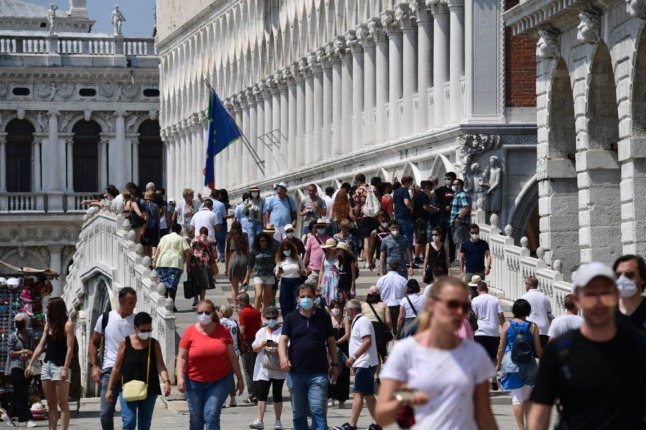This article was last updated on June 19th
Almost all remaining ‘yellow’ zones are being downgraded to the lowest risk classification ‘white’ zone status as of Monday June 21st.
The regions of Tuscany, Marche, Campania, Calabria, Basilicata, Sicily and the Autonomous Province of Bolzano will move from their yellow category, joining the rest of the country’s ‘white zones’.
The only area to remain a ‘yellow zone’ will be the northern region of Valle d’Aosta.
Under ‘white zone’ rules, regions can drop most of the restrictions currently in place in yellow zones, including the midnight curfew and the remaining restrictions on businesses and events.
READ ALSO: Delta variant in Italy: What’s the risk of another Covid-19 surge?
The health ministry confirmed the changes on Friday after its weekly coronavirus monitoring report showed Italy’s coronavirus numbers remained low last week.
Italy is divided into different-coloured zones indicating the level of coronavirus restrictions in place, with ‘red’ being the highest-risk zones, followed by orange and yellow. All regions are currently white or yellow.
Here’s the picture for Italy’s Covid-19 zones from June 21st:
Red zone: No regions
Orange zone: No regions
Yellow zone: Valle d’Aosta
White zone: Friuli-Venezia-Giulia, Molise, Sardinia, Abruzzo, Liguria, Umbria, Veneto, Emilia Romagna, Lazio, Lombardy, Piedmont, Autonomous Province of Trento, Puglia, Basilicata, Calabria, Campania, Marche, Autonomous Province of Bolzano, Sicily, Tuscany.
The map below shows how the country is divided:
What are the ‘white zone’ rules?
Regions are allowed to move into the low-restriction white zone if they have registered fewer than 50 coronavirus cases per 100,000 inhabitants for three weeks consecutively.
They also need to show other positive indicators, including a reproduction rate (Rt) under 1.
Italy in January added the ‘white’ tier to its system of coronavirus restrictions for the parts of the country where the coronavirus risk is lowest.
So far, only mask-wearing and social distancing rules must remain in place in white zones, the health minister has said.
Regions in the white zone will be able to drop the last remaining restrictions, and reopen trade fairs, theme parks, conferences and indoor swimming pools and hold weddings earlier than planned under the national roadmap for reopening.
For now, nightclubs and discos are still waiting for a firm date for reopening, and it is not known if or when Italy may relax the rules on wearing masks outdoors.
And the final set of rules in each region depends on the local authority, as each is free to impose stricter restrictions than those set by the national government.
The Italian health ministry on Friday meanwhile announced it will reinstate a mandatory quarantine requirement for all UK arrivals from Monday amid concerns about the spreading Delta coronavirus variant.



 Please whitelist us to continue reading.
Please whitelist us to continue reading.
There’s still no availability of free vaccines for everyone. We’ve been unable to apply for ASL due to lockdown.
Staggering, but not surprising the obstacles to healthcare.
This is not according to the ministero di salute, Piemonte is white as as below
Complessivamente, quindi, la ripartizione delle Regioni e Province Autonome nelle diverse aree in base ai livelli di rischio a partire dal 7 giugno 2021 è la seguente:
area rossa: (nessuna Regione e Provincia autonoma)
area arancione: (nessuna Regione e Provincia Autonoma)
area gialla: Basilicata, Calabria, Campania, Marche, Provincia Autonoma di Bolzano, Sicilia, Toscana, Valle d’Aosta
area bianca: Abruzzo, Emilia Romagna, Friuli Venezia Giulia, Lazio, Liguria, Lombardia, Molise, Piemonte, Provincia Autonoma di Trento, Puglia,Sardegna, Umbria, Veneto